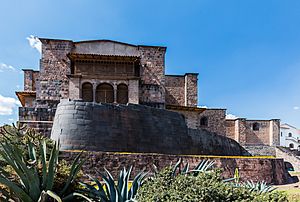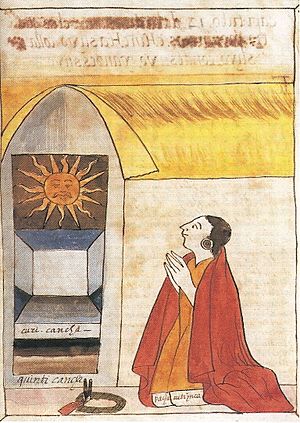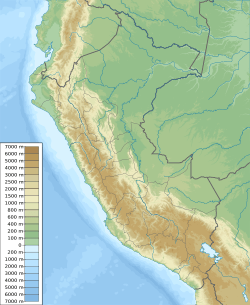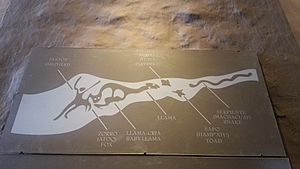Coricancha facts for kids
|
Qurikancha
|
|

Coricancha with Convent of Santo Domingo above
|
|
| Location | Cusco |
|---|---|
| Region | Andes |
| Coordinates | 13°31′12″S 71°58′32″W / 13.52000°S 71.97556°W |
| Type | Sanctuary |
| History | |
| Periods | Late Horizon |
| Cultures | Inca |

Coricancha, also known as Koricancha or Qorikancha, was the most important temple in the ancient Inca Empire. Its name means "The Golden Temple" in the Quechua language. It is located in Cusco, Peru, which was the capital city of the Inca Empire. This special place was dedicated to Inti, the Inca sun god.
Contents
History of Coricancha
Originally, this temple was called Intikancha or Intiwasi. It was built in Cusco, the Inca capital. Most of the temple was destroyed after the 16th-century war with the Spanish conquistadors. Spanish settlers used its stones to build their own churches and homes. Much of its original stonework became the foundation for the Santo Domingo Convent. This convent was built after a big earthquake in 1650.
Building the Golden Temple
To build Coricancha, the Inca used a special method called ashlar masonry. This means they used perfectly cut, similarly sized stones. Each stone was shaped to fit together without any gaps. This made the temple very strong and difficult to build.
The Inca chose this method to show how important the building was. It also showed their power to organize many workers. This building style was copied across the Andes mountains. It proved how much control the Inca had over a huge area.
Gold and Riches
Pachakutiq Inca Yupanqui was a powerful Inca ruler. He rebuilt Cusco and the Sun Temple, making it even grander. He added many plates of fine gold to the temple. He also provided gold and silver vases for the Mama-cunas, who were like nuns, to use in their services.
Pachakutiq also placed the bodies of seven past Inca rulers inside. They were decorated with masks, head-dresses, and jewelry made of gold. The walls of Coricancha were once covered in sheets of gold. The courtyard next to it was filled with golden statues. Spanish explorers described its richness as "unbelievable."
In 1533, the Spanish demanded a ransom in gold for the Inca leader Atahualpa. Most of this gold was collected from Coricancha.
Spanish Construction
The Spanish colonists built the Convent of Santo Domingo right on top of the temple. They tore down parts of the temple and used its strong foundations for their church. They also used stones for other buildings. This construction took almost a century.
Coricancha is one of many places where the Spanish used Inca stonework in their own buildings. Major earthquakes have badly damaged the church built by the Spanish. However, the original Inca stone walls are still standing strong. This is because of their amazing and precise stone masonry. There is also an underground archaeological museum nearby. It holds mummies, ancient textiles, and sacred objects from the site.
Inca Astronomy at Coricancha
Coricancha has special semicircular temples. These are similar to temples found in Machu Picchu and Písac. All three have a curved wall made of the finest stonework. These buildings were used to observe the sun's position during solstices. They also helped the Inca study their special constellations.
Stars and Constellations
The Inca called the Milky Way mayu, or Celestial River. They saw "dark areas" or "clouds" within it, which they called yana phuyu. They believed these were the shapes of animals drinking from the river.
Some of the animals the Inca saw in the stars included:
- A llama stretching from Scorpius to Alpha Centauri and Beta Centauri. These two stars formed the llama's eyes.
- A baby llama, llama-cría, upside down below the main llama.
- A red-eyed fox, atuq, located between Sagittarius and the tail of Scorpius.
- A partridge, yutu, just below the Southern Cross.
- A toad, hamp'atu, to the lower right.
- A serpent, machaguay, extending to the right.
Sun Worship and Rituals
During the Inti Raymi festival, the Sapa Inca (the emperor) and important leaders would go from the main square to Coricancha. They would greet the rising sun of the June solstice. Inside the "sun room" at Coricancha, the Sapa Inca would sit with the mummies of his ancestors.
This room and others were covered in gold plates. They were also decorated with emeralds and turquoise. The Sapa Inca would use a special mirror to focus the sun's rays. He would then light a fire to sacrifice llamas.
Coricancha is located where two rivers meet. According to Inca myths, this is where Manco Cápac decided to build Coricancha. This spot became the foundation of Cusco and the entire Inca Empire. Experts like Ed Krupp say the Inca chose this spot because it was like a special center point connecting the earth and the sky.
Images for kids
-
Colonial Cusco School paintings, inside
See also
 In Spanish: Coricancha para niños
In Spanish: Coricancha para niños
- Convent of Santo Domingo, Cusco
- List of buildings and structures in Cusco
- Pedro Cieza de Leon's The Chronicle of Peru
- Inca Garcilaso de la Vega's Comentarios Reales de los Incas
- Felipe Guamán Poma de Ayala's The First New Chronicle and Good Government
- Iperu, tourist information and assistance
- Tourism in Peru










